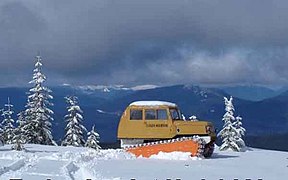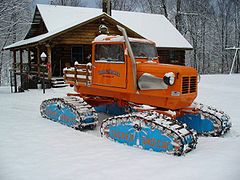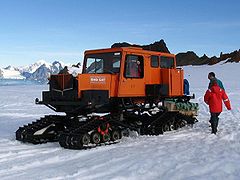Tucker Sno-Cat

The Tucker Sno-Cat Corporation is an American manufacturer of tracked vehicles that are manufactured as caterpillar tractors or snow groomers primarily for use in snow and ice and have been marketed under the company name Tucker Sno-Cat since the 1940s . They are produced at the company's headquarters in Medford , Oregon . The company is considered to be the oldest still existing manufacturer of snow groomers. The distinctive Sno-Cats ("snow cats"), usually provided with four crawlers, achieved particular fame through their use in American and British Antarctic expeditions in the 1950s.
history
The company was founded by Emmitt M. Tucker. The company's founder was born in 1892 as one of 13 children in the simplest of circumstances near the small town of Grants Pass in Oregon; he spent his early childhood near the small town of Trail in the same state. According to the company, the fact that he had to trudge through deep snow to school in winter made him think about transport options for snow-covered landscapes, which eventually led him to develop the snow groomers. According to the same source, he developed some vehicles based on the worm drive principle as early as the 1920s, but was unsuccessful. Then in 1938 he finally switched to the principle of caterpillars, which is still used in the company's vehicles today . Tucker, who then lived and worked in Los Angeles , moved to Grass Valley, California , where he set up the first manufacturing facility. Some time later he relocated the company to its current location in Medford (Oregon) . In 1941 he successfully tested a prototype at Crater Lake . In March 1948, he demonstrated the efficiency of his vehicle with a drive of about 1000 km from Mount Shasta to Mount Hood , which led over snow-covered paths and forest tracks.
In the 1950s and 1960s, Antarctic expeditions by various states, including the United Kingdom , the USA , France and Argentina , deployed Sno-Cats in significant numbers. The vehicles weighed between 3 and 11 tons, depending on the design. The interior was divided into the driver's cab and a room behind it that offered two to three people space to sleep. In the event of a defect in one of the four caterpillar tracks of the diesel engine- driven vehicles, the chain could be dismantled and the vehicle could continue to drive on three chains, the suspension of the dismantled chain acting as a skid .
In 1958 the United States Navy awarded the company the Certificate of Merit for its vehicles, in particular because they had proven themselves in use in Antarctica under the technical responsibility of the Seabees naval construction team .
In 1964, the UK Antarctic Place-Names Committee named a striking 1020 m high mountain in Graham Land on the Antarctic Peninsula after the Tucker Sno-Cat Corporation Mount Tucker .
Tucker Sno-Cats have also featured repeatedly on postage stamps , such as in 1988 on stamps from the British Antarctic Territory for the 30th anniversary of the Commonwealth Transantarctic Expedition and in 2010 on a postage stamp from the French Southern and Antarctic Territories .
As of the end of 2017, the company was still family-owned under the management of E. M. Tucker's granddaughter Marilee Tucker Sullivan and produced between 50 and 100 vehicles annually. Since the beginning of the 21st century , a collector's market for historical Sno-Cats has developed, especially in North America. 2017, the prices were for such copies depending on the state of conservation between about 10,000 and 100,000 dollars and had thus tripled in five years. The number of historical examples still in existence is estimated at a few thousand. In 2014 the company opened a branch for the purchase, sale and maintenance of historic vehicles under the direction of Jeff McNeil, a great-grandson of the company founder.
technology
The technical concept of the vehicles developed further over the decades, but remained true to the principle of the crawler belt. The early Sno-Cats, including the smaller models marketed as Sno-Kitten ("Snow Kitten"), had chains made of steel that also ran over hollow steel structures (pontoons) . The pontoons were later made from glass fiber reinforced plastic . Newer models use chains made of rubber . Most of the vehicles made by Tucker have two or four-seater cabs, but some models can accommodate up to 15 people and can reach speeds of up to 50 km / h. For a long time, widespread engines from major US commercial vehicle manufacturers were used for motorization, including six-cylinder side valve engines from Chrysler and, for larger models, eight-cylinder Hemi engines from Dodge .
The driver's cab and cockpit of today's Sno-Cats are modeled on normal pick-up trucks , with a steering wheel , gas and brake pedals and other controls. This makes it possible to operate the vehicle in an emergency even without instruction. The four chain drives are independently suspended and spring-loaded. All drives are oscillating around the axis of their drive wheel; this allows them to adapt to uneven ground so that the chain rolling on the drives has the greatest possible ground contact. All four chains are permanently driven. Tucker offers both chains with steel bars and solid rubber chains. Steering is achieved by rotating both the front and rear axles of the vehicle around the vertical. This is an essential difference to the steering of most tracked vehicles with only two crawler units, in which the change of direction takes place via different running speeds of the chains, for example by braking the caterpillar on the inside of the curve. The steering force is transmitted hydraulically . Standard components from the automotive industry are used for axles and hydraulics. The model series 1000, 1100, 1600 and 2000, offered in 2020 are from Cummins - diesel driven and have automatic the manufacturer Allison Transmission . Tucker also offers pendants with two or four chains.
Areas of application
Tucker Sno-Cats are still used in polar research, among other things for slope preparation , snow clearing , for patient transport and in search and rescue services , in prospecting for oil and natural gas , maintaining high-voltage lines , in mining and in agriculture as well as in the military . Since the beginning of the 21st century, more and more private individuals have also been buying Sno-Cats.
Pictures of Sno-Cats
Model 1700 in the Rothera station (2007)
Sno-Cat in the Canadian ski resort Mont Sutton (2007)
reception
- In the film How do you fish for a millionaire? shows Ranger Eben Tütü his forest area with the help of a Tucker Sno-Cat.
- As picture 108 "Antarctic expedition, tracked vehicle suspended in a crevasse, Great Adventures with the National Geographic" is a recording on the Voyager Golden Record in space go.
Web links
- Company homepage
Individual evidence
- ↑ a b Bernadette Hince: The Antarctic Dictionary: A Complete Guide to Antarctic English . CSIRO Publishing, Collingwood (Australia) 2000, ISBN 978-0-9577471-1-1 , pp. 324 ( digitized version in Google book search).
- ↑ SNO-CAT - Trademark Details. In: JUSTIA Trademarks. Retrieved March 14, 2020 .
- ^ A b c Edwin Battistella: Tucker Sno-Cat. In: The Oregon Encyclopedia . Portland State University & Oregon Historical Society , March 17, 2018, accessed March 7, 2020 .
- ^ A b c Tucker Sno-Cat Corporation. In: classiccatsbytucker.com. Accessed March 7, 2020 (English).
- ↑ Navy Honors Tucker Sno-Cat Corp. Extension of Remarks of Hon. Richard L. Neuberger of Oregon, in the Senate of the United States. In: Congressional Record . United States Government Publishing Office, Washington, DC August 5, 1958, pp. A6954 (English, digitized in the Google book search).
- ↑ Mount Tucker in the Geographic Names Information System of the United States Geological Survey
- ↑ 1988 British Antarctic. SG.163-6 - 30th Anniversary of Commonwealth Trans-Antarctic Expedition set 4 values U / M (MNH). In: john-rice-stamps.co.uk. Retrieved March 14, 2020 .
- ^ British Antarctic - Postage stamps - 1988 - The 30th Anniversary of the Commonwealth Trans-Antarctic Expedition, 1955-1958. In: stampworld.com. Retrieved March 14, 2020 .
- ↑ TF015.10 - SNO-CAT 743. In: WADP Numbering System (WNS). Universal Postal Union , Association mondiale pour le développement de la philatélie , accessed on March 14, 2020 (English, French, with a link to a high-resolution image of the postage, JPEG format ).
- ↑ a b c Kyle Stock: Toy of the Superrich: After 75 years, the market for Tucker Sno-Cat is hitting its peak. In: bloomberg.com . December 29, 2017, accessed March 8, 2020 .
- ↑ Performance. In: sno-cat.com. Tucker Sno-Cat Corporation, accessed March 20, 2020 .
- ↑ a b Models. In: sno-cat.com. Tucker Sno-Cat Corporation, accessed on March 20, 2020 (see also subpages for individual models).
- ↑ Felicity Aston: Polar vehicles get ice traction. In: Engineering & Technology online. March 16, 2015, accessed March 13, 2020 .








